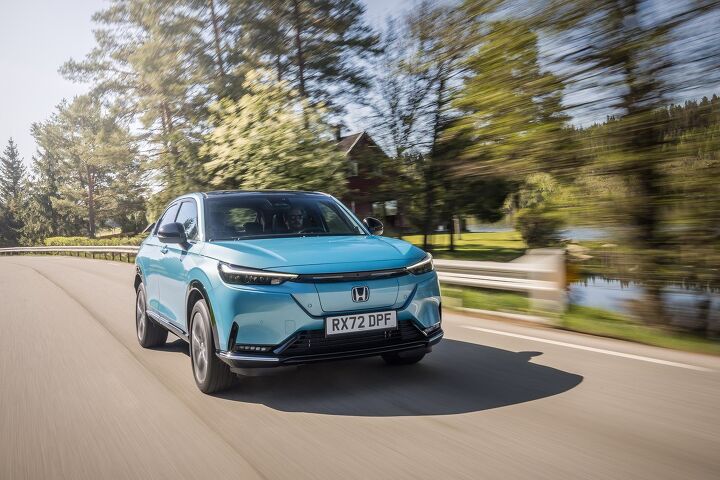
Honda is said to be changing the naming of its electric cars after customers, particularly those in China, found its name to be exceptionally difficult to pronounce. However, they weren’t the only ones. Europeans likewise didn’t appreciate the name, nor the odd choice of punctuation and capitalization that seems to plague some all-electric vehicles.
Your author has a admittedly ludicrous theory that some manufacturers have been giving compliance EVs terrible names because they subconsciously hope that people won’t buy them. This is pure speculation, obviously, and probably incorrect. But it’s difficult to imagine the meetings where they settled on Toyota bZ4X or Honda e:Ny1 ending in anything other than some soft crying.
Officially, the e:N prefix is supposed to stand for the new electric platform that will underpin Honda’s all-electric vehicles in the coming years (watch that change) and the y1 is the model designation. But this is even worse than when companies (e.g. Polestar or Tesla) simply give each model a single number or letter to identify itself. Besides, Honda already has a complete lineup of vehicles with excellent names — making the alphanumeric stuff that more confusing.
Despite nobody really digging the moniker, Honda has told Autocar that it only plans on changing the name of the model in China (as part of a more comprehensive facelift) because that’s where they’re having the most trouble and anticipated the largest sales volumes. But there have been rumors it might see its name change elsewhere, too.
“Customers in China just can’t pronounce it,” explained the source.
From Autocar:
In China, Honda uses either the e:NS1 or e:NP1 name for its small electric SUV, depending on whether the car is made by its joint venture with Dongfeng or that with GAC, while in Europe it uses e:Ny1.
Under the new naming scheme, Honda in China has kept the P and S letters depending on which joint venture builds the car, meaning it could in Europe rename the car the Y1.
Keeping the Y element would also avoid awkward conversions with McLaren or Audi if using the P1 or S1 name.
Audi has been very protective of its naming system, last year forcing Chinese EV maker Nio to change the name of its ES6 and ES8 SUVs on the basis that they sounded too much like S6 and S8.
The new P7/S7 is the first of Honda’s new Ye Series cars, based on a newly developed EV-specific platform. Honda has said it will launch a total of 10 new EVs in China by 2027.
If this sounds confusing, it’s because Honda actually wants to distinguish its all-electric models from the rest of its fleet. The brand believes it can sell EVs in China and simultaneously move EVs upmarket. Frankly, that sounds like an insane gamble if it were being done inside North America. But China sees EV proliferation as the best way to overtake the automotive industry, giving Honda an arguably better chance there.
While other nations have historically dominated the automotive detector, China currently rules the battery market without any direct peers. By doing what it can to pivot the whole world toward all-electric vehicles, it’s putting itself in a good position to become globally relevant in terms of automotive construction. Truth be told, the sheer number of parts suppliers situated within the nation already make China an essential part of most vehicle’s supply chain. However, the Chinese government feels like the path forward is to create global EV brands that will out-compete legacy manufacturers from other countries.
Market conditions have changed quite a bit in recent years as the economy weakened. But most companies still see China as one of the few markets where small, affordable EVs have a chance of turning a profit. Unfortunately, this also meant the market was flooded with those exact types of models — making the segment very competitive with leaner margins than most automakers would have hoped for. Oversupplying has become a problem, meaning Honda is going to need every advantage it can get if it wants to stay in the fight.
Sadly, Autocar stated that the brand is already having difficulties here as loads of Chinese EV brands continue going under. The e:NS2 mid-size hatchback that was recently launched in China is reportedly being sold at a substantial loss and went to market with the naming convention the company is now considering abandoning.
Meanwhile, the relatively small e:Ny1 that also presently sells in the United Kingdom for £39,995 (roughly $50,200 USD at the current exchange rate) is being heavily discounted to ensure the company hits regional emissions targets after opting not to sell the even smaller Honda E. That presumably isn’t solely the result of it having a lackluster name and likely has more to do with the fact that that’s fairly expensive for the segment it’s trying to occupy. That’s something we have seen on our market and more than occasionally.

[Image: Honda]
Become a TTAC insider. Get the latest news, features, TTAC takes, and everything else that gets to the truth about cars first by subscribing to our newsletter.

